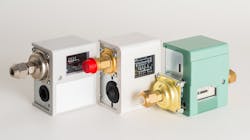Q: Is it possible to use a "voting" system between switches and transmitters simultaneously?
For example, for voting 2oo3 is it possible to use one digital signal plus two analog signals like one pressure switch and two flow meter transmitters? Is it possible to combine transmitters threshold outputs (that are DO signals) with a switch output? We are using voting selection between three digital signals. "Multiple selection criteria are typically offered by “voting” modules, including high, low, average, and median." So median selection is not disparate from voting, it`s one of the voting methods. Furthermore, I did not find any article limiting median selection for analog signals. In case of median selection for three voters, one can compare analog with digital systems.
Analog: If the threshold of transmitters is set on 5, then the inputs of [1.5, 5.3, 7] will trigger the output, because 2oo3 signals are higher than threshold.
Digital: The inputs of [H, L, H] will trigger the output, because 2oo3 signals are high.
Mehrdad Bokaeiann
[email protected]
A1: Good, often asked question and the answer is yes, you can mix them. Today, with the spread of autonomous vehicle and robot controls, a good understanding of this question is becoming more important. So let us look at some of the considerations:
- First, you have to decide if your system is to serve safety (SIS) or process control (PC). The main goal of PC is to increase measurement availability (increase uptime, reduce shutdowns), while SIS is dormant, it serves to minimize spurious alarms and in an emergency act to bring the system to a safe status. It does that using software diagnostics, not on the basis of system conditions.
- Now, as to combining transmitter DOs with common switches, you must decide if convenience or reliability is your primary goal. If it is reliability, you will use simple mechanical switches, while if it is convenience (and not so much reliability) you would use transmitter DOs, which are less reliable as they require external power supplies and electronics, plus they are easier accessed by malware attacks.
- Your decision could also be influenced by the application, because for example in the coming age of hydrogen fuels, some transmitter will not be able to handle the low temperatures of liquid hydrogen.
- Median selection is different from voting. The mix you suggest can handle redundancy and voting but not median selecting, because that requires that all three signals to be transmitter outputs.
Using a continuous transmitter instead of discrete switches also provides the ability to easily change the alarm or trip value, and also provides better diagnostic capability. The latter point is not as obvious as the former and deserves more explanation.
A transmitter continuously measuring say a liquid level will produce an output signal that varies over time with the measured process variable. A “healthy” transmitter should therefore exhibit a continuously changing output signal, proportional to the degree of change in the process. Discrete process switches, in contrast to transmitters, provide no indication of “healthy” operation. The only time a discrete process switch changes its state is when its trip point is reached, which in the case of safety shutdown sensors indicate dangerous (rare) conditions. Therefore, it is possible for a switch to have failed in its “normal” position, thereby being incapable of registering a dangerous condition should one arise, while a DO signal, which is continuously varying, because it is an output of a process transmitter, is not subject to that risk.
Two transmitters and one switch filtered through a median select function or a voting function, does not provide you with 2oo3 safety, because if just one of the transmitters is signaling an alarm condition while the switch and the other transmitter indicates normal, the majority conclusion is wrong.
Béla Lipták
[email protected]
A2: Not just possible, but potentially more reliable due to using disparate devices in the voting sequence, hence less common cause failure percentage. I have used this before today in improving an existing safety system with too high spurious trip rate (without buying any more sensors)! 1oo1 to 2oo3.
Ian H. Gibson
[email protected]
A3: Convenience and reliability are not the same thing. In terms of safety evaluation, the former should be given a lower priority for consideration. A transmitter, because of its dependency on external power supply and internal electronics, is far less reliable than a simple mechanical switch that provides a pair of dry contacts in playing its role of tripping. One needs to consider the basic operating principles of the two different instruments to evaluate overall safety and reliability. In my limited experience in instrumentation at minus 40 C, none of the LCD displays of the transmitters work, causing a sense of insecurity to the field operators.
I tend to request the instrument technicians to check the switches in the field more often than to sit back in the control room entirely using an asset manage system to infer overall plant safety. Switches cannot be replaced by transmitters, no matter how convenient it is to check the functionality of a transmitter. Health of an instrument system is not how fast nor how convenient of obtaining a signal alone. Such health should also include the environment in which the instruments are installed, which governs the overall safety of a process plant. Often process plants get bigger as it becomes more convenience to infer safety from transmitters. However, the size and the price of accidents in process plants become bigger as time goes by.
Gerald Liu
[email protected]
A4: While this could be done, I'd be reluctant to call such an arrangement "median select.” A true median select requires three analog signals. How are you going to handle or vote the two analog signals, 1oo2 or 2oo2? The result of those two transmitters would then be combined with the discrete signal (switch), again using either a 1oo2 or 2oo2 arrangement. So, it's not exactly 2oo3.
Paul Gruhn
[email protected]
About the Author
Béla Lipták
Columnist and Control Consultant
Béla Lipták is an automation and safety consultant and editor of the Instrument and Automation Engineers’ Handbook (IAEH).

Leaders relevant to this article:


